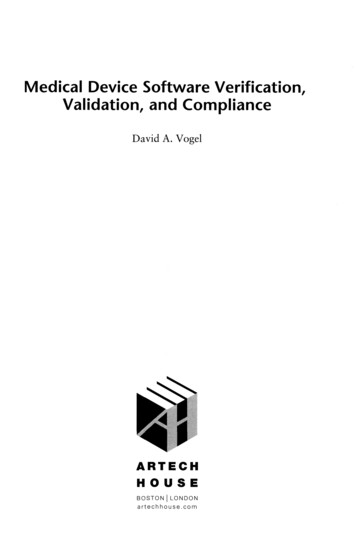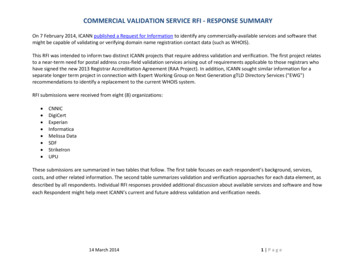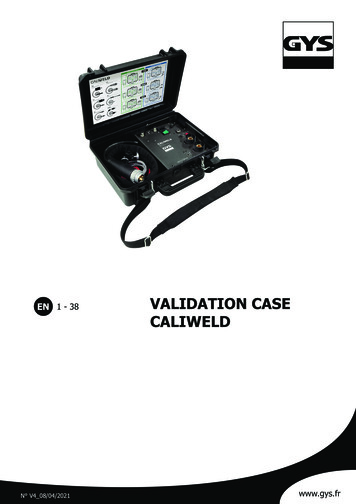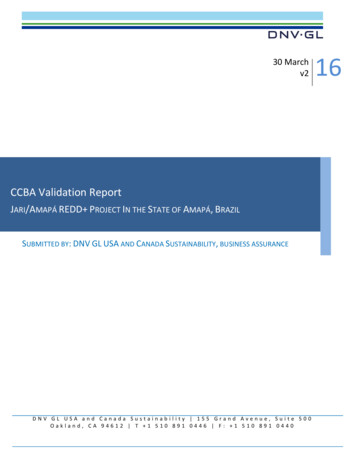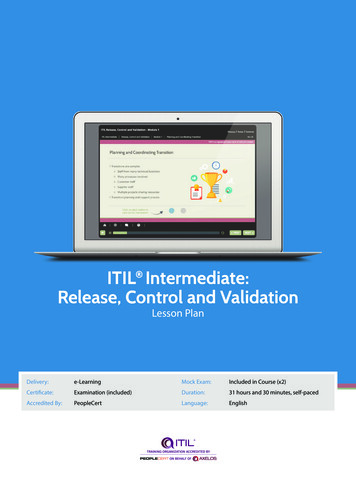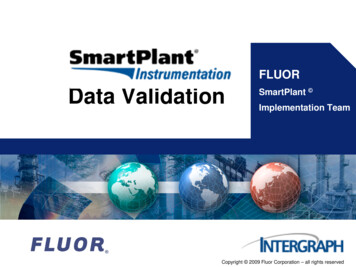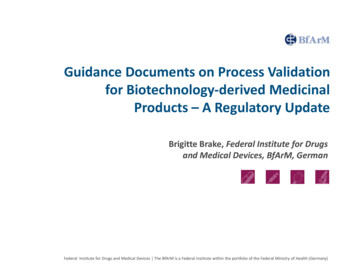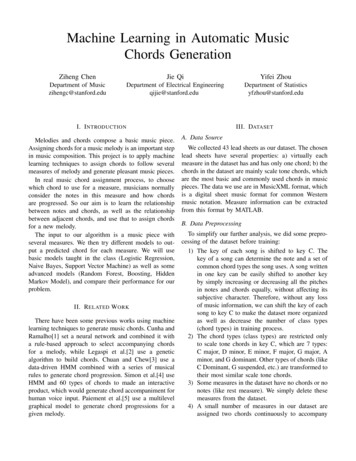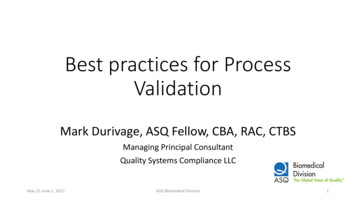
Transcription
UNCLASSIFIEDDoD Public Key Enablement (PKE) Reference GuideContact: dodpke@mail.milURL: http://iase.disa.mil/pki/pkeCertificate Validation CapabilityRequirements and Best Practices8 August 2012Version 1.1DOD PKE TeamUNCLASSIFIED
Certificate Validation CapabilitiesUNCLASSIFIEDRevision HistoryIssue Date07/29/20108/8/2012Revision1.01.1Change DescriptionDocument DevelopedUpdated DoD PKE support email addressiiUNCLASSIFIED
Certificate Validation CapabilitiesUNCLASSIFIEDContentsINTRODUCTION . 4PURPOSE.4SCOPE .4MINIMUM REQUIREMENTS . 5ALGORITHMS AND KEY SIZES .5BASIC VALIDATION STEPS .5REVOCATION CHECKING .5BEST PRACTICES . 5ALGORITHMS AND KEY SIZES .5BASIC VALIDATION STEPS .5REVOCATION CHECKING .6Methods and Failover Configuration.6OCSP Implementation .7CRLs Implementation .7INTEROPERABILITY CONSIDERATIONS .8Policy Control .8Cross-Certificate or Implicit Path Processing .8Delegated Validation.9APPENDIX A: ACRONYMS AND DEFINITIONS . 10ACRONYMS.10DEFINITIONS .10APPENDIX B: STANDARDS & POLICIES. 12RFC 5280: INTERNET X.509 PUBLIC KEY INFRASTRUCTURE CERTIFICATE AND CERTIFICATE REVOCATION LIST (CRL) PROFILE .12HSPD 12: POLICY FOR A COMMON IDENTIFICATION STANDARD FOR FEDERAL EMPLOYEES AND CONTRACTORS .12FIPS PUB 201-1: PERSONAL IDENTITY VERIFICATION (PIV) OF FEDERAL EMPLOYEES AND CONTRACTORS.12NIST SP 800-78-2: CRYPTOGRAPHIC ALGORITHMS AND KEY SIZES FOR PERSONAL IDENTITY VERIFICATION .12NIST DRAFT SP 800-131: RECOMMENDATION FOR THE TRANSITIONING OF CRYPTOGRAPHIC ALGORITHMS AND KEY SIZES .12NIST SP 800-57: RECOMMENDATION FOR KEY MANAGEMENT.13FIPS 140-2: SECURITY REQUIREMENTS FOR CRYPTOGRAPHIC MODULES.13APPENDIX C: TEST RESOURCES. 14NIST PKI TEST SUITE (PKITS) .14DOD JOINT INTEROPERABILITY TEST COMMAND (JITC) TEST SUITE .14APPENDIX D: FEDERAL COMMUNITY SIZE ESTIMATE . 15APPENDIX E: SUPPORT . 16Website .16Technical Support .16iiiUNCLASSIFIED
Certificate Validation CapabilitiesUNCLASSIFIEDIntroductionThe DoD Public Key Enablement (PKE) Reference Guides are developed to help anorganization augment their security posture through the use of the Public KeyInfrastructure (PKI).PurposeThe purpose of this document is to provide vendors and other custom applicationdevelopers with guidelines for designing certificate validation capabilities that meetDoD and federal interoperability requirements and technical constraints for certificatebased authentication.ScopeThis document addresses certificate validation practices, with an emphasis onrevocation checking functionality and interoperability support.4UNCLASSIFIED
Certificate Validation CapabilitiesUNCLASSIFIEDMinimum RequirementsAlgorithms and Key SizesThe system must support Rivest, Shamir and Adleman (RSA) keys up to 4096 bits withSecure Hash Algorithm (SHA)-1 and SHA-2 digital signatures as dictated by theNational Institute of Standards and Technology (NIST) Special Publication (SP) 800-57,SP 800-78 and draft SP 800-131 (see Appendix B).Basic Validation StepsThe system must implement the basic validation steps outlined in section 6.1.3 of theinternet X.509 certificate specification [Request for Comment (RFC) 5280]1.Revocation CheckingThe system must provide the capability to check certificate revocation status as part ofthe certificate validation process (as defined in RFC 5280). If the revocation status of acertificate cannot be determined, the system must be configurable to fail closed,meaning that access is denied to the possessor of the end entity (EE) certificate forwhich revocation status cannot be determined.Best PracticesAlgorithms and Key SizesThe DoD and its coalition partners currently use RSA keys up to 4096 bits with SHA-1digital signatures. Within the next few years, the DoD and federal communities willmove to Elliptic Curve Cryptography (ECC) keys as well. SHA-256 digital signaturesare mandated for use starting January 1, 2011. The system should support all of thesealgorithms and key sizes for validating digital signatures on signed objects includingcertificates (in compliance with NIST SP 800-78), and for native application digitalsignature generation (in compliance with NIST SP 800-57 and draft SP 800-131). Moredetailed information on required algorithms and timelines can be found in NIST SP 80057, SP 800-78 and draft SP 800-131.Basic Validation StepsSection 6.1.3 of the internet X.509 certificate specification [RFC 5280]2 defines the basiccertificate processing steps that any implementation should follow. A more condensed,practical version of this specification’s requirements can be found in the draft w.ietf.org/rfc/rfc5280.txt5UNCLASSIFIED
Certificate Validation CapabilitiesUNCLASSIFIEDRecommendation for X.509 Path Validation3; requirements in the Bridge-Enabledsection of this document (Section 4) should be included to meet federal interoperabilityrequirements. Note that the draft recommendation references RFC 32804, which hasbeen superseded by RFC 5280.Revocation CheckingMethods and Failover ConfigurationThe best practice for certificate revocation checking mechanisms is to provide multiplemethods with failover capabilities. In general, DoD’s preferred order of revocationchecking methods (where the first method is primary, with failover to the subsequentmethods in listed order) is:1) Online Certificate Status Protocol (OCSP)2) Local Certificate Revocation List (CRL) cache3) CRL distribution points (CRL DP)The logic behind this configuration that the OCSP is preferred for use when available.When OCSP is unavailable, local CRL caches are preferred over CRL DPs due to thesize of DoD CRLs and performance/possible denial of service implications for userswho must wait for CRLs to download in real time from their distribution points inorder for the user’s certificate to be checked for revocation. In scenarios where the CRLmay not exist in the local cache, dynamic CRL retrieval via CRL DP should besupported to ensure that the user is not denied service because a valid CRL is notavailable locally.This reasoning is generally applicable for most DoD environments; however, for themost flexibility to meet individual deployments’ needs, the ideal implementation wouldprovide a configuration option that allows the administrator to specify the preferredorder of revocation check methods. In addition, a configurable threshold of validationrequest volume above which the system will switch to a different preferred methodorder for a particular issuing Certification Authority (CA) can provide traffic volumedriven performance tuning.The system should be configurable to deny a user access (fail secure/closed) ininstances where a certificate’s revocation status cannot be determined by any of theavailable means.3http://csrc.nist.gov/groups/ST/crypto apps infra/documents/NIST Recommendation for X509 PVMs.pdf4 http://www.ietf.org/rfc/rfc3280.txt6UNCLASSIFIED
Certificate Validation CapabilitiesUNCLASSIFIEDOCSP ImplementationResponder Location/URLFor OCSP support, the system should support use of the Authority Information Access(AIA) value in the certificate to determine the OCSP responder URL. The systemshould also provide a configurable default responder URL value for each CA certificatein the trust store, with the options to fail over to the default value when the OCSPresponder URL is not included in the AIA field of the certificate to be validated, or touse the default value as an authoritative value that overrides whatever may be listed inthe AIA field.Trust Model SupportThe system should support the Delegated Trust Model (DTM) for OCSP responsesignatures by default, with the capability to configure use of the Explicit Trust Model orCA-signed Trust Model instead.Nonce SupportThe system should be configurable to include nonces in OCSP requests, forcing theresponder to retrieve the certificate status and generate the response at the time of therequest rather than allowing it to use a pre-signed response.Local CacheThe system should be configurable to locally cache OCSP responses. The refreshschedule for the cached data should be configurable to provide the capability to requirea data refresh more frequently than required by the validity periods of the responses,but should never exceed the Next Update date of the response.CRLs ImplementationLocal CacheThe system should be configurable to use a local cache of CRLs to check revocationstatus of certificates. The system should ensure that retrieval of new CRLs for the localcache does not cause denial of service, and that users can authenticate against locallycached valid CRLs while new CRLs are being retrieved and populated in the localcache. This cache should also be capable of handling the volume of CRL data that atypical federal interoperability implementation might require. For example, currentlythe DoD CRLs comprise about 200 MB of data. Assuming that the entire federalcommunity is roughly twice the size of the DoD (see Appendix D) and accounting forgrowth and error, 500 MB of CRL data might be reasonable to expect for a federalinteroperability implementation. To improve performance when dealing with largeCRLs, support of technologies such as partitioned and delta CRLs should beconsidered.7UNCLASSIFIED
Certificate Validation CapabilitiesUNCLASSIFIEDSimilarly to the OCSP response cache, the refresh schedule for the CRL cache should beconfigurable, but should never exceed the Next Update date of the response.CRL DPsThe system should be capable of retrieving CRLs from CRL DPs at run time and addingthem to the local cache if the appropriate CRL for the certificate being validated doesnot already exist in the local CRL cache. Similarly to the OCSP responder URL value,the system should support use of the CRL DP value in the certificate to determine theCRL DP URL, as well as provide a configurable default value per CA certificate in thetrust store that can be used as either an override or failover value for the CRL DP valuein the certificate.Interoperability ConsiderationsPolicy ControlThe system should be configurable to require EE certificates to assert an allowed policyobject identifier (OID) in their Certificate Policies extension in order to authenticate. Forhuman readability, it is preferable to provide the capability to configure allowed OIDsper trust anchor. However, since each PKI has a unique OID arc, a white list approachcan also be used. If the white list approach is taken, it is recommended that thecapability to include comments in, or otherwise annotate, the configured OID list beprovided to aid the administrator in tracking which allowed OIDs correspond to whichorganizations.Cross-Certificate or Implicit Path ProcessingTo facilitate the use of cross-certificates in certificate paths, the system should supportuse of both AIA and Subject Information Access (SIA) extensions for path processing.Any path building algorithms should also prefer the shortest valid path.The system should also ensure that the “hint list” sent to the browser does not result inthe browser prohibiting the user from selecting a certificate that could have a valid pathto a configured trust anchor through a cross certificate. For systems that have thecapability to dynamically build paths (i.e. do not require that all certificates in a pathother than the EE certificate be explicitly stored in the trust store), the hint list should beempty/null to support certificates that chain to trusted roots through cross-certificates.For systems that require all trusted CAs in a path to be explicitly included in the truststore, the hint list can include all trusted roots.8UNCLASSIFIED
Certificate Validation CapabilitiesUNCLASSIFIEDDelegated ValidationIncluding support for technologies such as Server-based Certificate Validation Protocol5(SCVP) that allow the entire certificate validation process to be delegated to an externalentity should be LASSIFIED
Certificate Validation CapabilitiesUNCLASSIFIEDAppendix A: Acronyms and DefinitionsAcronymsAIACACRLCRL LAuthority Information AccessCertificate AuthorityCertificate Revocation ListCRL Distribution PointDepartment of DefenseDelegated Trust ModelElliptical Curve CryptographyEnd EntityNational Institute of Standards & TechnologyOnline Certificate Status ProtocolObject IdentifierPublic Key EnablementPublic Key InfrastructureRequest for CommentRivest, Shamir and AdlemanServer-based Certificate Validation ProtocolSecure Hash AlgorithmSubject Information AccessSpecial PublicationUniversal Resource LocatorDefinitionsarcCA-signed Trust ModelDelegated Trust ModelExplicit Trust ModelA specific OID sub-tree assigned to anorganizationOCSP trust model in which the OCSP clientexpects the OCSP response to be signed by thesame CA that issued the certificate for whichstatus is being requestedOCSP trust model in which the OCSP clientexpects the OCSP response to be signed by acertificate issued for OCSP signing by thesame CA that issued the certificate for whichstatus is being requestedOCSP trust model in which the OCSP clientexpects the OCSP response to be signed by acertificate explicitly identified in the client’sconfiguration10UNCLASSIFIED
Certificate Validation CapabilitiesnonceUNCLASSIFIEDA set of random bits that can be included in anOCSP request to force a fresh (rather than presigned) response11UNCLASSIFIED
Certificate Validation CapabilitiesUNCLASSIFIEDAppendix B: Standards & PoliciesThe following are standards and policies pertinent to certificate validation andcryptography requirements.RFC 5280: Internet X.509 Public Key Infrastructure Certificateand Certificate Revocation List (CRL) s standard specifies the standard validation activities for X.509 certificate pathvalidation, along with a sample algorithm for executing the necessary activities. It alsodescribes the structure of X.509 v3 certificates and X.509 v2 CRLs.HSPD 12: Policy for a Common Identification Standard forFederal Employees and Contractorshttp://www.dhs.gov/xabout/laws/gc 1217616624097.shtmThe Homeland Security Presidential Directive that orders the implementation of amandatory, Government-wide standard for physical and logical identification.FIPS PUB 201-1: Personal Identity Verification (PIV) of FederalEmployees and fips201-1/FIPS-201-1-chng1.pdfThe standard that implements HSPD 12. Section 6.2.4 defines the required PIV PKIcertificate validation process.NIST SP 800-78-2: Cryptographic Algorithms and Key Sizes forPersonal Identity pubs/800-78-2/sp800-78-2.pdfContains approved PIV algorithms for various cryptographic uses and timelines for use.NIST Draft SP 800-131: Recommendation for the Transitioningof Cryptographic Algorithms and Key 131/draft-sp800-131 spd-june2010.pdfSection 9 discusses approved hash functions, and requires that digital signaturegeneration be done with SHA-2 functions (which for most practical purposes for thefederal government translates to use of SHA-256) starting January 1, 2011. Forcertificate validation purposes, this means certificates and revocation data signed withSHA-256 need to be able to be used in the certificate validation process.12UNCLASSIFIED
Certificate Validation CapabilitiesUNCLASSIFIEDNIST SP 800-57: Recommendation for Key bs/800-57/sp800-57-Part1-revised2 v/publications/nistpubs/800-57/sp800-57 PART3 keymanagement Dec2009.pdfDiscusses best practices for key management and provides guidance for cryptographicalgorithm and key size selection.FIPS 140-2: Security Requirements for Cryptographic 140-2/fips1402.pdfDefines requirements for cryptographic modules of systems with sensitive butunclassified (SBU) contents. The current list of FIPS-validated modules is available 140-1/140val-all.htm.13UNCLASSIFIED
Certificate Validation CapabilitiesUNCLASSIFIEDAppendix C: Test ResourcesThe following are PKI test resources that may be useful in verification of a certificatevalidation capability.NIST PKI Test Suite (PKITS)http://csrc.nist.gov/groups/ST/crypto apps infra/pki/pkitesting.htmlSuite includes test cases as well as test data to aid in execution of the test cases.DoD Joint Interoperability Test Command (JITC) Test SuiteTest rmance testing of relying party clientcertificate path v1 07 september 28 2001.Test mance testing of relying party clientcertificate path v1 07 certificates.zip14UNCLASSIFIED
Certificate Validation CapabilitiesUNCLASSIFIEDAppendix D: Federal Community Size EstimateDepartmentDefenseStaff TypeCivilianActive Duty MilitaryReservist/ NationalGuard**ContractorTotalVeterans AffairsHomeland icultureInteriorHealth and Human ing and Urban DevelopmentEducationSocial Security AdministrationNational Aeronautics and SpaceAdministration Protection AgencyEnvironmentalGeneral Services AdministrationOffice of Personnel ManagementSmithsonian InstitutionOther Independent AgenciesJudicial branchLegislative branch*Other Dept Contractors**Intelligence communityTotalNumberAs of [1][1][4][4][4][4][4][4][4][4][4][5]* Estimated at 50% of workforce for all departments with unlisted contractor counts**Rough estimates are provided for these groups based on publicly available informationSources[1] -branch[2] [3] y-contract-employees-senators-charge.aspx[4] http://www.bls.gov/oco/cg/cgs041.htm[5] munity.htm15UNCLASSIFIED
Certificate Validation CapabilitiesUNCLASSIFIEDAppendix E: SupportWebsiteVisit the URL below for the PKE website.www.iase.disa.mil/pki/pkeTechnical SupportContact technical support through the email address below.dodpke@mail.mil16UNCLASSIFIED
The system must provide the capability to check certificate revocation status as part of the certificate validation process (as defined in RFC 5280). If the revocation status of a certificate cannot be determined, the system must be configurable to fail closed, meaning that access is denied to the possessor of the end entity (EE) certificate for
